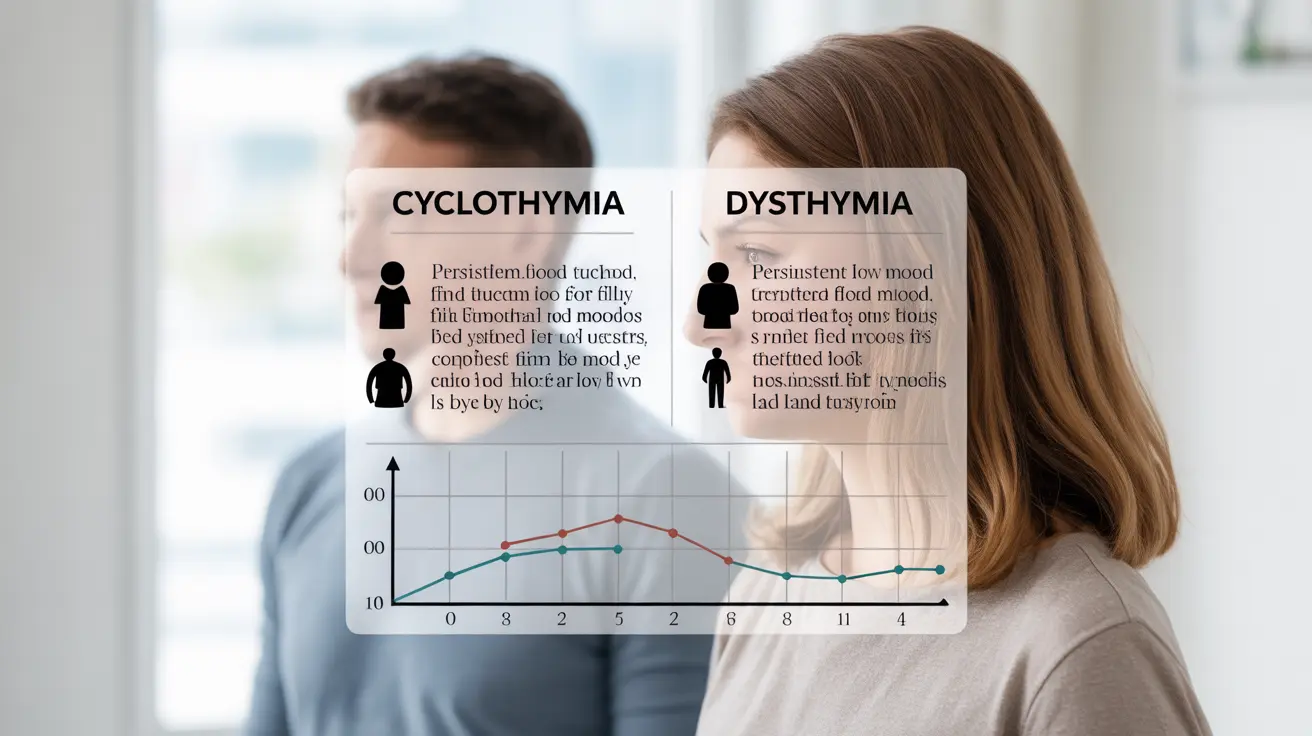Living with mood disorders can be challenging, especially when trying to understand the specific nature of your condition. Cyclothymia and dysthymia are two distinct mood disorders that, while sharing some similarities, have unique characteristics and treatment approaches. Understanding these differences is crucial for proper diagnosis and effective management.
In this comprehensive guide, we'll explore the key distinctions between cyclothymia and dysthymia, their diagnostic criteria, treatment options, and important considerations for long-term management.
Defining the Conditions
Cyclothymia
Cyclothymia is characterized by chronic, fluctuating mood disturbances involving periods of hypomanic symptoms alternating with periods of mild depression. These mood swings are less severe than those experienced in bipolar disorder but can significantly impact daily life.
Dysthymia
Dysthymia, also known as persistent depressive disorder, involves chronic, low-grade depression that persists for extended periods. While the symptoms may be less intense than major depression, their persistent nature can profoundly affect quality of life.
Key Symptomatic Differences
Cyclothymic Symptoms
People with cyclothymia experience:
- Periods of elevated mood and increased energy
- Episodes of mild depression
- Mood fluctuations that occur frequently
- Irregular sleep patterns
- Variable levels of productivity and sociability
Dysthymic Symptoms
Those with dysthymia typically show:
- Persistent low mood
- Consistent fatigue
- Poor concentration
- Low self-esteem
- Changes in appetite
- Sleep disturbances
Diagnostic Criteria and Timeline
For cyclothymia, symptoms must persist for at least two years in adults (one year in children and adolescents), with symptom-free periods lasting no longer than two months. The condition involves both hypomanic and depressive periods that don't meet full criteria for major episodes.
Dysthymia diagnosis requires depressive symptoms lasting at least two years in adults (one year in children and adolescents), with symptom-free periods not exceeding two months. The depression is typically less severe but more chronic than major depressive disorder.
Treatment Approaches
Managing Cyclothymia
Treatment for cyclothymia often includes:
- Mood-stabilizing medications
- Cognitive behavioral therapy
- Lifestyle modifications
- Regular sleep schedule maintenance
- Stress management techniques
Managing Dysthymia
Dysthymia treatment typically involves:
- Antidepressant medications
- Psychotherapy
- Social support enhancement
- Regular exercise
- Mindfulness practices
Risk Factors and Prevention
Both conditions share some common risk factors, including:
- Family history of mood disorders
- Traumatic life events
- Chronic stress
- Biological factors
- Environmental influences
Prevention strategies focus on early intervention, stress management, and maintaining a healthy lifestyle. Regular mental health check-ups can help identify and address symptoms before they become severe.
Frequently Asked Questions
- What are the main differences in symptoms between cyclothymia and dysthymia?
Cyclothymia involves alternating periods of hypomania and mild depression, while dysthymia presents as persistent, low-grade depression. Cyclothymia shows mood fluctuations, while dysthymia maintains a more consistent depressed state.
- How are cyclothymia and dysthymia diagnosed and how long do symptoms need to last?
Both conditions require symptoms to persist for at least two years in adults (one year in children). Diagnosis involves professional evaluation of symptom patterns, with cyclothymia requiring both up and down cycles, while dysthymia requires persistent depression.
- What treatment options are available for managing cyclothymia versus dysthymia?
Cyclothymia typically requires mood stabilizers and therapy, while dysthymia is usually treated with antidepressants and psychotherapy. Both conditions benefit from lifestyle modifications and regular mental health support.
- Can cyclothymia develop into bipolar disorder, and how can this be prevented?
Yes, cyclothymia can progress to bipolar disorder in some cases. Prevention involves consistent treatment adherence, regular monitoring, stress management, and maintaining a stable lifestyle routine.
- What are common risk factors for cyclothymia and dysthymia and how do they affect mood disorders?
Common risk factors include genetic predisposition, trauma history, chronic stress, and environmental factors. These elements can trigger or exacerbate mood symptoms, making early identification and intervention crucial for better outcomes.




